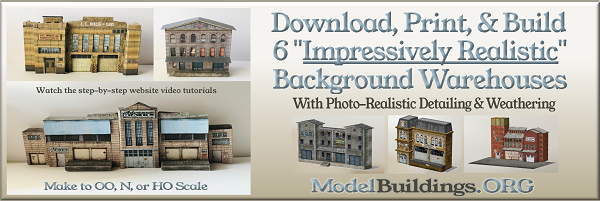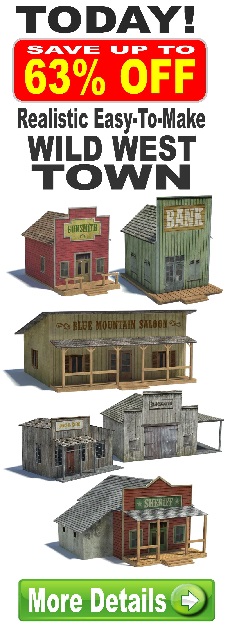Everything on model trains, model railroads, model railways, locomotives, model train layouts, scenery, wiring, DCC and more. Enjoy the world's best hobby... model railroading!
Why Do Trains Derail on 22 inch Curves?
Andrew H asks readers:
“I bought a new HO scale diesel loco with 6 trucks. However, it keeps on derailing when crossing the turnouts. I originally had 18 inch curves and changed these to 22 inch curves, but I didn’t replace the turnouts. My question – Should I replace my existing turnouts with #6’s (22 inch curves)? Will this reduce the likelihood of future derailments?”
13 Responses to Why Do Trains Derail on 22 inch Curves?
Leave a Reply
















Hi , 18 or 22 inch curve are not too extreme. i would say its nothing to do with curves, your trucks might need a good look over or may be a little modification. My MK1 wagons used to derail 3 radious turns i actually intruduce some weight to the wagons now they are alot better. you can buy weight or also you can check the wagons and their couplings are they turning freely or they are stuck? hope these help.
Your comment that the derailment only happens when crossing turnouts may be where you need to look closely. Some of the check rails may be a little too high and or there may not be enough clearance between them and the running rail, if not take a small file and carefully ease away some of the material making up the check rail. Look carefully at the turnout when propelling a wagon by hand see if there is any unnecessary vertical movement. The earlier comment about adding weight to the truck is also very valid. You did not mention the speed of the train, this may also be a contributing factor. Good luck with your investigations.
Is the loco derailing when running alone or with wagons on tow? If the loco pass the switches without anny problem when traveling alone you should check the couplings. If they do not move freely they may cause the problem. You write that your loco has 6 trucks, I take it that it is 3 axels in each boggie. Boggies with 3 axels are a bit longer than boggies with 2 axels. Check if the corners of the boggie hit something on the undercarrige of the loco. Easy to check if you put the loco upside down and put a 18″ or 22″ rail on the Wheels and move it back and forward.
Yes get rid of the ’18” ‘ turnouts. They are actually 15″ as the have a short straight part on each end and derailments are guaranteed with 6 wheel trucks and modern flanges.
2ft radius turrnouts and 19″ curves is the minimum radius for reliable running, Always us use larger radius for the turnouts as the straight end section makes the curve tighter than the box suggests
We really can’t give you a usable response with the information given. Please tell us the type of loco, maker, wheel configuration. If the loco is from a reputable manufacturer it should go through 22″ curves without a problem. Contrary to popular belief 15″ and 18″ curves in HO are quite feasible, if not visually convince models of real track. Most modern diesel and small wheelbase steam locos should have not trouble with 15″ curves and larger steam locos should negotiate 18″ curves. Most of the visible sections of my layout have (or will have) 24″ radius curves. I have planned for 2 helixes and they will have both 15″ and 18″ curves joined by straight 200mm sections. I use Peco code 100 in hidden areas I envision no problems negotiating a 600mm lift over 6 “rings” using SAR 830, 900 and 930 class diesel locos, light Mikados and Pacific steam locos. Why will this work – easements into curves, super elevation and very careful construction coupled with locos and rolling stock with correct gauge and back to back, lubricated bearings on all rolling stock (I use powdered graphite) and rolling stock weighted to NMRA Recommended Practice. DCC Concepts magnetic adhesion system will be used under the curves.
In the above you will note the importance of correct gauged wheels, proper back to back (Check that before attacking the track components with a file), and in gauge trackwork. If all those are in order and the track is properly laid .locos will stay on the track.
Back to basics and all will be well.
I have had problems with 6-axle diesels as well. They do not like 18″ radius. You need check the wheel gauging carefully. I find that most locos and cars are out of gauge and need adjustment. On 6-axle locos I will set the middle axel a little narrower than the gauge. I find this solves most of the loco derailment issues.
If the above recommendation do not solve the problem, my next and first step is to check the gauge of the loco and the track. I have purchased a number of loco especially 6 axle that came out of the box out of gauge.
There are many different manufacturers of trains and track. As David says, if you let us know the make and details of the locos and track, someone with the same setup would be able to share their experience.
When buying locomotives for a layout, check if the manufacturer states a minimum radius curve for that loco.
This is mainly an issue with multiple axle steam locos, which have a long fixed wheelbase, so there is a limit on how tight curves can be. (The wheels tend to jam between the rails if the radius is too small.)
Carl’s point is good: if the loco trucks are not designed to turn far enough, they may be obstructed by other parts of the loco’s underbelly. If this happens, you might be able to file something down to fit.
Carefully examine the turnouts with a magnifier so see if anything is twisted or bent or not aligned.
Move the loco slowly over the turnout, watching the wheels with the magnifier, to detect the exact cause of the problem
You should also check the points on the turnouts. Some are a little thick and may need to be gently filed to smooth them and let them align more closely to the track. Also, as someone else said, check for free movement of the trucks. I recently bought a Broadway Limited 6 axle and the brake lines that ran along the top of the trucks were occasionally snagging on the body of the loco (an SD9). It was a simple matter to press them down toward the top of the truck to stop the snagging. Good luck
#4 turnouts are 18″ radius-curved. if your c-c loco won’t take 18″ radius curves, you will need to replace all of your #4 turnouts with #6’s if you must run that loco.
I had the same problem at one time. After extensive troubleshooting I found a couple of my turnouts were on the tight side of the clearance tolerances. As it was only one (an Athearn HO scale Trainmaster) out of my whole roster of engines that were giving me this trouble, and that the said turnouts were in a remote spot and not easily reached for replacement I decided simply to remove the flanges from the centre axles of the trucks on this particular engine, works like a charm, no more derailments. Nobody that I didn’t tell beforehand have as yet noticed the lack of those flanges.
Murphy is madder than hell at me for cheating him. 🙂
I would definitely use 22″ curves minimum, I found out the hard way and I was having my locos de-rail, so I changed all my 18″ s to 22″ s. I think you need to either change your turnouts to# 6, # 8 are better if you have the room, you can use curved turnouts or if you really want a de-rail proof turnout, you can build them from scratch, you can buy the template and the rail and ties.
Good luck,
Chuck
18 inch radius switches commonly called no 4 turn outs will many times give larger engines and cars a hard time and this includes 3 axle truck dome cars. I have been installing at least a No 6 switch which is much closer to 22 inch radius.Sometimes your engine wheel trucks hit framework near the truck and do not let the truck turn as far. Remember that most actual railroads curve and switches are not near as sharp as the model railroads. and the shallower your track is the better. (including the switches Also your guard rails through your switches need to have the clearance from the stock rail and some model trucks do not allow enough flex on each axle from side to side. If you have ever had 4 wheel passenger cars then negotiating an 18 inch radius the is tuff mainly due to frame steps and castings on the bottom of the cars do not allow them to turn sharp enough. One person asked me one time Do I trim off the things in the way ? I suggested no because as you increase your collection you may also improve the radius you need to run them and then you have cars that have been poorly modified. But that is your choice. I did some when I was younger and now that I have adjusted my tracks I now face the work to improve the cars back to near original. Don’t purchase better cars and engines if your tracks are not ready. You don’t want to make modifications that someday you will regret later. from Newman